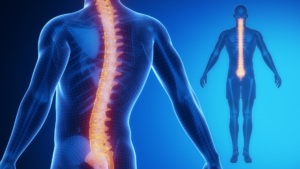Cognitive Behavioral Therapy is a treatment approach that combines techniques to help people identify and correct faulty patterns of thoughts, feelings, and behaviors. The goal is to increase function and reduce pain.
A Brief History
Cognitive Behavioral Therapy was developed in the mid-1970s by Dr. John Sarno, a clinical professor of rehabilitation medicine at New York University School of Medicine. It is based on his belief that most lower back pain results from unconscious emotional factors, particularly feelings of stress and anxiety in the muscles of the lower back and abdomen.
According to Dr. Sarno, when people unconsciously repress feelings or emotions they often experience physical symptoms in the body as a consequence of the unconscious mind acting to protect them in some way.

Treating Low Back Pain with CBT
He believes that most people who develop lower back pain have repressed anger toward someone else or themselves, which he calls ‘core beliefs’. Core beliefs are often formed in childhood and are the result of unresolved emotional conflicts. The pain creates fear, further suppressing emotions, resulting in a vicious cycle.
Dr. Sarno’s approach focuses on getting patients to become aware of these unconscious emotions and how they affect their physical well-being through persistent pain. He teaches people to reinterpret the pain in a positive way, as a sign that they can now initiate the healing process.
How Cognitive Behavioral Therapy Works
Cognitive Behavioral Therapy takes place in six to eight weekly sessions, each lasting an hour. The first session is about education and explaining how pain might develop. The remaining sessions are spent discussing memories in the patient’s life that may be linked to the pain, identifying repressed emotions, and working out strategies to deal with them.
The interactive sessions aim to help patients become aware of patterns that can trigger their pain, such as poor time management or expectations set too high by family members. They also explore how a patient’s thoughts and emotions affect the sensations in the lower back. A key part of Cognitive Behavioral Therapy is becoming aware of ‘early warning signs’ so they can be acted upon before pain becomes a problem.
Cognitive Behavioral Therapy for Lower Back Pain focuses on the mind-body connection and how emotions affect physical health, partially through stress hormones such as cortisol, which have been linked to chronic pain.
The Approach’s Value
In some cases, Cognitive Behavioral Therapy for Lower Back Pain permanently reduces or eliminates pain. In one study, 78% of people with chronic lower back pain reported that treatment was successful and they were able to return to work.
A review of research found that the approach was effective for chronic lower back pain, but not acute low back pain. In addition to treatment sessions, Cognitive Behavioral Therapy for Lower Back Pain encourages people with lower back pain to keep a daily diary. This helps them become more aware of their thoughts and behavior patterns that may be contributing to or exacerbating the pain.
When to Seek Cognitive Behavioral Therapy for Lower Back Pain
People who meet the following criteria would likely benefit from Cognitive Behavioral Therapy for Lower Back Pain:
- Have experienced pain in their lower back at least once a day for the previous three months.
- Have been unable to take medication or engage in physical therapy because it hasn’t worked for them in the past.
- Do not have a severe, progressive illness that could be causing their lower back pain.
Patients with the most severe pain and functional disabilities may need additional medication, acupuncture, and physical therapy.
Final Thoughts
Chronic lower back pain is a prevalent and costly condition. People with chronic lower back pain must receive effective treatment that focuses on self-management or self-care measures.
Cognitive Behavioral Therapy for Lower Back Pain may be an effective intervention for this group of people. Still, the approach works best when both patient and therapist are committed to participating in all sessions without exceptions.
If you suffer from chronic back pain and want to learn more about this approach, contact Progressive Pain Management to discuss your treatment options.
Pain affects every aspect of your life, and normal daily activities are challenging when living with chronic pain. From the amount of sleep you get to the thoughts you have, pain can negatively affect your quality of life.
Your day-to-day activities are crucial in managing your pain and maintaining a healthier life. Positive changes to your routine and lifestyle are excellent ways to reduce pain and improve your mood.
Simple changes and additions to your daily life can make managing your pain easy.

Learn how to Manage Chronic Pain at Home
How to Manage Chronic Pain at Home
Deep Breathing or Meditation
Practicing relaxation skills such as breathing exercises, visual imagery, meditation, and mindfulness are some techniques that can help you center yourself and take your focus off the pain you experience.
Reducing Stress
Stress and Pain go hand-in-hand. When you are stressed, your body may react in different ways – such as tensing muscles – which can increase your pain. This can be prevented by reducing and managing your stress.
Stress can have a negative impact on your relationships, work ethic, eating habits, and mood. Keep a list of what stresses you out and consider how it affects your life. Once you have a list of stressors, think of ways you can minimize them or eliminate the triggers. For example, if you get stressed and feel rushed during the work week, brainstorm ways you can make the week easier by incorporating things like meal prep, picking out your outfit the night before, or other ways to make the week go more smoothly.
Stay Active
If you struggle from pain, exercise may provide the relief you are looking for. Cardio exercises use large muscle groups and raise your heartrate, which releases endorphins – you body’s natural painkillers. Exercising for 30-45 minutes of low-intensity aerobic exercise is recommended and can help relieve pain.
Talking with your doctor before starting any new exercise program is important.
Get More Sleep
It is no secret that pain can interfere with a good night’s sleep. You may have issues falling asleep or staying asleep throughout the night. Medications can cause sleep issues, too. If your pain medication causes drowsiness and fatigue, you may be more inclined to sleep during the day instead of at night. Getting a proper amount of sleep at night is important to how your body copes with pain and how your body boosts your energy levels.
Here are some ways to sleep better:
- Practice Relaxation: Write in a journal, listen to soothing music, or practice deep breathing techniques to help prepare your body for restful sleep.
- Set a Schedule: Routine sleeping can help you get better sleep. Go to bed at the same time and set an alarm for the same time each day.
- Be Mindful of What You Eat and Drink: Caffeine and alcohol can affect sleep patterns, as well as heavy meals. If you need a snack before bed, try almond butter on toast, crackers and cheese, or nuts and fruit.
Managing your pain at home is achievable when you have the support of a comprehensive care physician. Get the help you need from the team at Progressive Pain Management by filling out the form below.
Spinal cord stimulation (SCS) has emerged as a transformative approach to managing chronic pain conditions that have proved resistant to traditional therapies. This article delves into the groundbreaking field of SCS, shedding light on its mechanisms, applications, and potential to revolutionize pain management.
Chronic pain conditions represent a significant healthcare challenge, affecting millions of individuals worldwide. When conventional treatments fail, spinal cord stimulation (SCS) offers a promising alternative. This innovative approach has shown considerable efficacy in managing refractory chronic pain conditions, providing relief and improving the quality of life for many patients.

Spinal cord stimulation as a revolutionary approach to pain management
Understanding Spinal Cord Stimulation
SCS involves the delivery of low-level electrical pulses to the spinal cord, interfering with the transmission of pain signals to the brain. This process effectively ‘masks’ pain signals, replacing them with a tingling sensation known as paresthesia.
The Evolution of Spinal Cord Stimulation
The concept of SCS can be traced back to the 1960s, with the introduction of the Gate Control Theory of pain by Melzack and Wall. This theory proposed that non-painful input closes the ‘gates’ to painful input, preventing pain sensation from traveling to the central nervous system. This theory laid the foundation for the development of SCS.
Mechanism of Action
SCS works by modulating the pain signals at the spinal level, before they reach the brain. The electrical pulses delivered by the stimulator compete with the pain signals, effectively ‘drowning them out’ and preventing them from reaching the brain.
Applications of SCS
SCS has been successfully employed in managing various chronic pain conditions, such as:
- Failed Back Surgery Syndrome (FBSS)
- Complex Regional Pain Syndrome (CRPS)
- Ischemic and coronary artery disease
Benefits of SCS
SCS offers numerous advantages over traditional pain management therapies. These include:
- Effectiveness: SCS has shown considerable efficacy in reducing pain intensity and improving the quality of life for patients with refractory chronic pain conditions.
- Customizability: The stimulation parameters can be adjusted to meet the individual needs of each patient, ensuring optimal pain relief.
- Cost-effectiveness: Despite the high initial cost, SCS can be a cost-effective solution in the long run, especially when compared with other long-term therapies.
Challenges and Limitations
While SCS offers numerous benefits, it is not without its limitations. These include the invasive nature of the procedure, potential for complications, and the requirement for ongoing management and adjustment of the stimulator settings.
Advancements in Spinal Cord Stimulation Technology
Over the years, significant advancements have been made in SCS technology. Modern devices are more sophisticated and reliable, offering improved pain relief and fewer complications.
The Future of Spinal Cord Stimulation
The field of SCS is evolving rapidly, with ongoing research and development paving the way for more effective and safer solutions for chronic pain management.
Conclusion
In conclusion, SCS represents a revolutionary approach to chronic pain management. By modulating pain signals at the spinal level, SCS offers a promising alternative for patients who have not found relief through conventional therapies. As research and technology continue to advance, the future of SCS looks promising, offering hope for millions of individuals living with chronic pain. Talk to the professionals at Progressive Pain Management to learn more about spinal cord stimulation therapy and if this treatment is effective for your chronic pain. Fill out the form below to get started.

